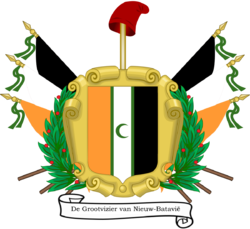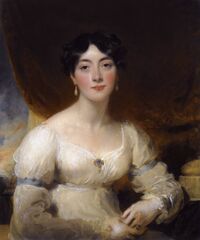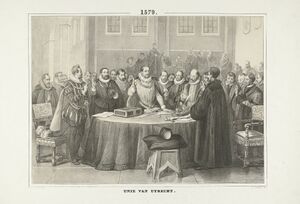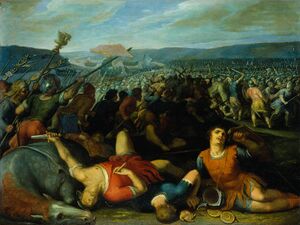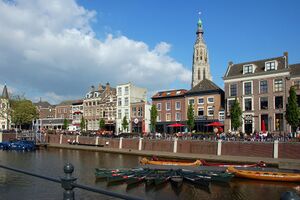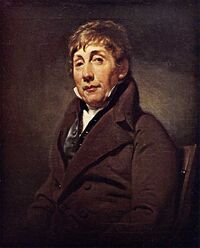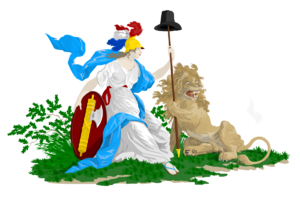MicrasWiki:New Batavia/featured pictures: Difference between revisions
| Line 6: | Line 6: | ||
{|style="width: 100%;" | {|style="width: 100%;" | ||
|style="width:33%; border: 0px" rowspan="1" | | |style="width:33%; border: 0px" rowspan="1" | | ||
[[File:Coa Grand Vizier of New Batavia.png| | [[File:Coa Grand Vizier of New Batavia.png|250px|center|Coat of arms of the Grand Vizier of New Batavia]] | ||
|style="border: 0px" | | |style="border: 0px" | | ||
The coat of arms of the [[Grand Vizier of New Batavia]] was adopted by [[Executive decrees of New Batavia/UB symbolen nationale overheidsinstellingen 2020|executive decree]] on December 6, 2020. It features the New Batavian [[Wikipedia:Escutcheon_(heraldry)|escutcheon]] on an elaborate console. It's supported by orange, white and black flags and a phrygian cap. The cap is a well known symbol of the French revolution, which inspired the Batavian revolution, and in turn inspired the formation of the micronational [[Netherlands|Republic of the Netherlands]]. Many institutions of that Republic's constitution are still in place in the current [[Constitution of New Batavia|New Batavian constitution]]. | The coat of arms of the [[Grand Vizier of New Batavia]] was adopted by [[Executive decrees of New Batavia/UB symbolen nationale overheidsinstellingen 2020|executive decree]] on December 6, 2020. It features the New Batavian [[Wikipedia:Escutcheon_(heraldry)|escutcheon]] on an elaborate console. It's supported by orange, white and black flags and a phrygian cap. The cap is a well known symbol of the French revolution, which inspired the Batavian revolution, and in turn inspired the formation of the micronational [[Netherlands|Republic of the Netherlands]]. Many institutions of that Republic's constitution are still in place in the current [[Constitution of New Batavia|New Batavian constitution]]. | ||
Revision as of 15:04, 25 July 2021
August 2021
Featured picture
|
The coat of arms of the Grand Vizier of New Batavia was adopted by executive decree on December 6, 2020. It features the New Batavian escutcheon on an elaborate console. It's supported by orange, white and black flags and a phrygian cap. The cap is a well known symbol of the French revolution, which inspired the Batavian revolution, and in turn inspired the formation of the micronational Republic of the Netherlands. Many institutions of that Republic's constitution are still in place in the current New Batavian constitution. Read more:
|
May 2021
Featured picture
|
Rania Lucius is a leading politician of the New Batavian Democratic Social Movement. She is the youngest daughter of former Flemish president Marcus Lucius and a sister of the former Batavian politician Alexandra Lucius. In 2021 AD she became vizier of culture in the IRP-DSB coalition cabinet, led by Grand Vizier Redouan van Lucerne. The original portrait was painted by Thomas Lawrence and pictures Elizabeth Belli, mrs Horsley Palmer. Her husband, John Horsley Palmer, was an English banker and governor of the Bank of England from 1830 to 1833. Read more:
|
April 2021
Featured picture
|
In 1579 AD the Union of Utrecht was signed, unifying several provinces in present day Belgium and the Netherlands in their fight against Habsburg Spain. The Union of Utrecht is often regarded as the founding document of the Dutch Republic and its first constitution. In 2007 AD a micronational Union of Utrecht was drafted, creating the Virtual United Provinces, a predecessor of New Batavia. The document served as the nation's first constitution. The United Provinces' culture and politics were inspired by the historical Union. This lithograph was made between 1782 and 1799 by Albertus Anthonius Nunnink. It depicts the taking of a solemn oath at the signing ceremony of the treaty and was also used on the original wiki of the Virtual United Provinces. It's part of the collection of the Rijksmuseum in Amsterdam. Read more:
|
March 2021
Featured picture
|
In 1613 AD painter Otto van Veen painted Batavians defeating Romans on the Rhine. It depicts a battle between the Germanic tribe of the Batavi, lead by Gaius Julius Civilis, against the Romans in 69 AD. The Batavi were victorious, but were defeated by the Romans one year later. The battle was described by historian Tacitus. In the 5th century AD the Batavi were still mentioned, but later probably merged with the tribe of the Franks. The Dutch named many places after the Batavi, including the Batavian Republic. "New Batavia" is etymologically related to "Batavi". Read more:
|
February 2021
Featured picture
|
Breda is a city in the Dutch province of North Brabant. During the Dutch war of independence, it became part of the Dutch Republic. The city is close to the Dutch-Flemish border and hence was chosen as the site for a so called macronational conference for the Dutch sector of micronationalism in 2009. Present were, among others, Erwin V.H., Hieronymus Erasmus and Frans. In the Dutch sector, the city is best remembered for the Breda Crisis, in which Flanders attempted to annex the Netherlands. | |
Read more:
|
January 2021
Featured picture
|
Redouan van Lucerne was Grand Vizier of the government-in-exile of the Islamic Internet Republic and after the Restoration Grand Vizier of New Batavia. He was instrumental in the Restoration of the Republic. His cabinet later stressed good relations with other nations and signed several friendship treaties. Van Lucerne's avatar is a painting of the in-real-life Dutch politician Carel de Vos van Steenwijk (1759-1830). It was painted by the British painter Charles Howard Hodges. | |
Read more:
|
December 2020
Featured picture
| The Dutch Maiden (Nederlandse Maagd) is a national personification of the Netherlands. She is typically depicted wearing a Roman garment and with a lion, the Leo Belgicus, by her side.
The Dutch Maiden has been used as a national symbol since the 16th century. During the Dutch Revolt, a maiden representing the United Provinces of the Netherlands became a recurrent theme in allegorical cartoons. On 25 May 1694, the States of Holland and West Friesland introduced a uniform coin design for the United Provinces, showing a Dutch Maiden leaning on a bible placed on an altar and holding a lance with the cap of liberty, the Liberty pole. The Dutch maiden was also used on Micras by New Batavia's predecessors the Republic of the Netherlands and the Islamic Internet Republic. | |
Read more:
|
